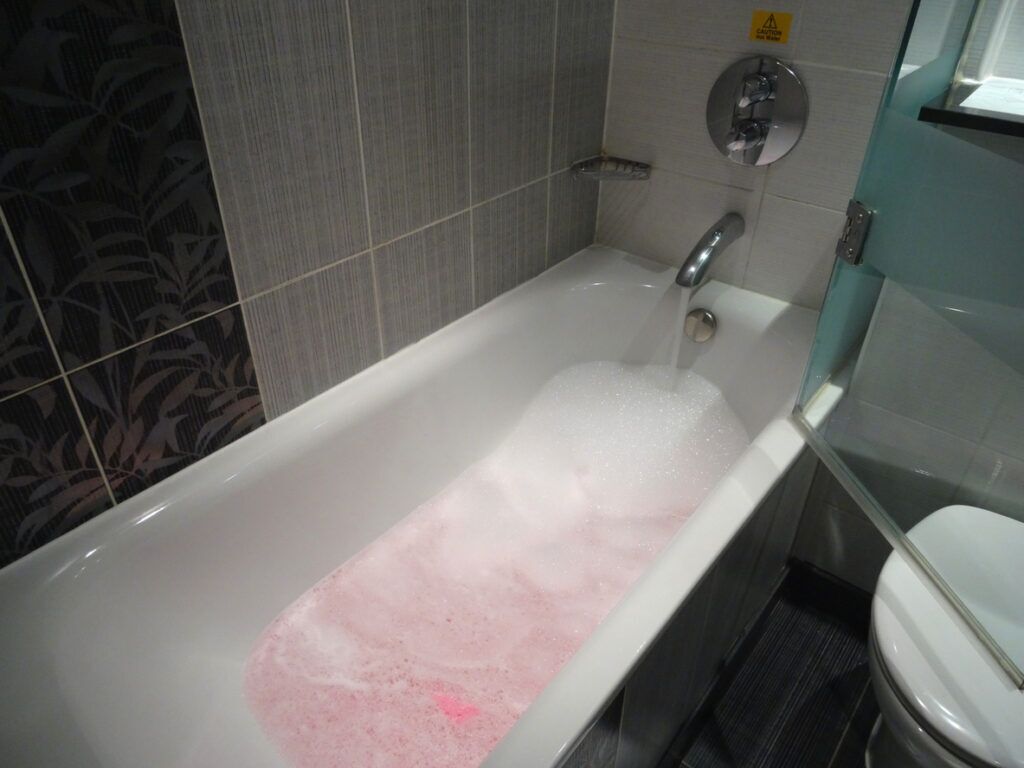Top Reasons Behind Sewage Backflow in the Bathtub
Top Reasons Behind Sewage Backflow in the Bathtub
Blog Article
Every person will have their personal idea on the subject of What To Do If Sewage Starts Backing Up Into the Shower.

Sewer back-up in the bath tub can be a traumatic and unsanitary issue for any property owner. Not just is it inconvenient, however it additionally positions significant health and wellness threats and indicates underlying concerns with the plumbing system. Understanding why sewer is turning up through the tub is critical for taking suitable activity to address the problem efficiently.
Intro to the Concern
Usual Reasons for Sewage Backup
Blockages in the Drain Line
Among one of the most usual sources of sewer back-up is an obstruction in the drain line. This can happen due to the build-up of particles, grease, or international things in the pipelines, preventing appropriate circulation and triggering sewage to support into your bath tub.
Tree Root Breach
Tree roots seeking wetness and nutrients can penetrate sewage system lines via tiny cracks or joints. Gradually, these roots can expand and expand, creating significant damages to the pipes and leading to sewage back-up issues.
Comprehending the Problem
When sewage starts backing up into the bath tub, it's a clear indication of a trouble with the drainage system. The wastewater that ought to be streaming far from your home is instead discovering its back right into your space, which can result in significant damage and carcinogen.
Potential Causes
Numerous aspects can add to sewer backup in the bathtub. From obstructions in the sewer line to problems with the plumbing facilities, determining the origin is vital for locating a remedy.
Aging Infrastructure
Older homes may have outdated plumbing systems that are much more prone to rust, cracks, and wear and tear. As pipelines age, they end up being extra prone to leakages and blockages, raising the likelihood of sewer back-up cases.
Heavy Rainfall or Flooding
Throughout periods of heavy rainfall or flooding, the drain system may come to be overwhelmed with excess water, triggering backups and overflows. This can lead to sewage supporting right into tubs and other fixtures inside the home.
Signs of Sewage Back-up
Foul Odors
Unpleasant smells originating from drains pipes or components, specifically in the restroom, may suggest sewer backup issues. These odors are frequently solid and persistent, signifying a trouble that requires instant attention.
Slow Draining Fixtures
Bath tubs, sinks, and bathrooms that drain pipes gradually or otherwise in all could be experiencing sewer backup. If multiple components are affected at the same time, it's most likely that the issue stems from an usual factor, such as the main sewer line.
Gurgling Noises
Weird gurgling or bubbling sounds originating from drains pipes when water is running in other places in your home are a sign of air entraped in the plumbing system. This air buildup can result from sewage back-up and must be investigated without delay.
Health Risks Related To Sewage Backup
Contamination of Supply Of Water
Sewage back-up can contaminate the water in your home, posturing a serious health risk to you and your household. Exposure to polluted water can bring about stomach issues, skin infections, and other ailments.
Mold and mildew Growth
Dampness from sewage back-up can develop suitable conditions for mold development in your house. Mold spores can intensify respiratory issues and trigger allergic reactions in sensitive people, making timely clean-up necessary.
Spread of Condition
Sewage contains damaging germs, viruses, and parasites that can cause a range of illness, including liver disease, cholera, and gastroenteritis. Entering into contact with sewer or contaminated surface areas places you at risk of infection.
Tidying up After Sewage Backup
Sanitation Procedures
Thoroughly decontaminate and disinfect affected areas after sewer backup to get rid of harmful germs and protect against mold growth. Usage ideal cleaning products and protective equipment to make certain safe and efficient clean-up.
Reconstruction of Impacted Areas
Fix any type of damages to floor covering, wall surfaces, or fixtures caused by sewer backup. Relying on the degree of the damage, you might need to replace carpeting, drywall, or various other products to recover your home to its pre-loss condition.
Immediate Actions to Take
Switching Off Water
In case of sewer back-up, it's important to shut off the water supply to prevent further contamination and damages. Find the main water shutoff valve in your house and shut it off until the concern can be solved.
Getting In Touch With a Professional Plumber
Managing sewage back-up is not a DIY work. Contact an accredited plumber with experience in dealing with sewage-related concerns to assess the circumstance and execute necessary repair services or cleanings.
Avoiding Contact with Polluted Water
Up until the sewer back-up is fixed, prevent contact with infected water to stop the spread of microorganisms and pathogens. Wear protective gear if you should be in the affected area and wash your hands extensively afterward.
Safety nets
Routine Maintenance of Drain Lines
Arrange routine inspections and upkeep of your drain lines to identify and address prospective issues before they rise right into major problems. This can include cleaning out debris, checking for tree origin breach, and repairing any damaged pipelines.
Mounting Backwater Shutoffs
Think about mounting bayou shutoffs in your plumbing system to avoid sewage from receding right into your home during durations of heavy rainfall or flooding. These shutoffs immediately close when water draws back up, safeguarding your home from contamination.
Correct Disposal of Home Waste
Prevent purging anything other than toilet tissue and human waste down the bathroom to stop obstructions and blockages in the sewer line. Dispose of grease, oil, and other home chemicals appropriately to lessen the threat of plumbing issues.
Why is There Sewage Coming Up Through the Bathtub
Sewage in your bathtub is a major problem that can make you want to abandon the bathroom for good. You don’t have to. However, it is important to identify the source of the issue and take the necessary steps to resolve it in order to avoid any health risks and property damage. In this article, we will discuss what could be causing sewage to back up through your bathtub so you can take action quickly and effectively.
The Main Reason For Sewage Backup in The Bathtub
All the sinks and toilets in your home connect to different pipes that lead to the main sewer line. The sewer line then connects to the municipal sewer system. This connection works seamlessly on a daily basis, but there can sometimes be a problem with the main sewer line.
The most common cause of sewage backup is a clogged or blocked main sewer line. The main sewer line can be clogged due to the accumulation of debris, tree roots or grease buildup, or other materials. Another possible cause is a collapsed pipe. When this happens, your toilets and sinks won’t be able to drain properly. This is when sewage starts backing up through the bathtub. If the problem has been occurring for some time now, it might be time to consult with a plumber as there may be more severe damage that needs fixing.
How Can You Tell if it’s Coming From Your Sewer Line?
If you’re experiencing a sewage backup in your bathtub, then you can use a few simple methods to determine if it is coming from the main sewer line. First, try to unclog the tub drain with a plunger or an auger and see if that helps. If not, then inspect all of the drains in your house and check if there is any blockage in them. If some of the other drains are not working fine, then it’s likely the problem is with your main sewer line.
Common Signs of a Clogged Main Sewer Line
If you suspect that your main sewer line is blocked, then there are a few common signs to look out for. Frequent clogs in your home are a sure sign of a clogged sewer line. You can also check for slow drainage from all the plumbing fixtures.
Slow Drains
If you notice that it takes longer for your sinks and toilets to drain, then this could be a sign of a clogged main sewer line.
Frequent Clogs
Another common sign is that your drains or toilets become clogged almost all of the time. If this happens, then it could be a sign that the main sewer line is blocked.
Water Backup
Do you notice water or sewage coming back up from any of the drains in your home? If your answer is yes, you may have a clogged main sewer line.
Sinkholes
If you’ve noticed sinkholes in your yard or overflowing sewage from the ground, you may be facing a blocked sewer line issue.
Your Shower or Sink Makes Gurgling Noises
Have you noticed gurgling noises coming from your sink or shower lately? These are typically signs of a blocked sewer line and should be checked out immediately.
How to Prevent a Main Sewer Line Clog
Once you’ve identified that your main sewer line is clogged, it’s important to take steps to prevent it from happening again. The best way to do this is to avoid putting any solid material that can clog the drain, such as grease and other debris. You should also be mindful of what you flush down your toilet. In addition, you should schedule regular maintenance for your main sewer line. This will help keep it clear and free from clogs or backups.
What Should You do if You Notice Sewage Backing up Through The Bathtub?
If you’ve noticed sewage backing up through the bathtub, then it is important to call a professional plumber immediately. A plumber can inspect the situation and determine what the cause is, such as a blocked main sewer line. They will also be able to advise you on how best to fix the issue. In some cases, a simple drain cleaning may be all that is needed.
However, if the blockage is severe, then your plumber may need to use more advanced methods to clear the blockage.
No matter what, it is important to always call a professional plumber if you experience any kind of sewage backup. They will be able to assess the situation and provide you with a solution that is best for your home.
https://baylorinc.com/blog/why-is-there-sewage-coming-up-through-the-bathtub/

Do you enjoy reading about What To Do If Sewage Starts Backing Up Into the Shower? Give feedback directly below. We'd be pleased to see your reactions about this blog posting. We hope that you come back again in the near future. Those who appreciated our blog post please be sure to share it. Thank you for your time. Kindly check our website back soon.
Order Repair
Report this page